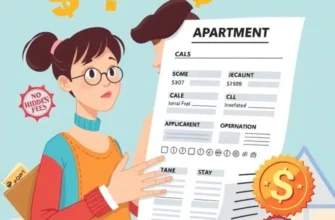So, you’ve found yourself in a rental predicament! Perhaps the apartment you’ve rented is more of a ‘never-ending nightmare’ than a cozy abode, or maybe life has decided to throw some unexpected twists your way—hello, job offer in Timbuktu! Breaking a lease can feel like a Herculean task, but fear not! This guide is here to offer friendly tips and a dash of humor as we walk through the right steps to break your lease while keeping your sanity intact. Whether you’re a first-time renter or a seasoned leaseholder, understanding your rights and responsibilities is key. Remember, life is too short to live in a place that doesn’t suit you. Let’s make sure you leave your lease like a boss, with minimal fuss and maximum fun.
Finding Your Escape Clause: Know Your Rights

Before contemplating lease termination, it’s imperative to dissect your lease agreement thoroughly. Comprehending its clauses can make or break your exit strategy. Let’s start by discussing common points like the ‘early termination’ clause.
Early Termination Clause:
This clause is your first port of call. It often outlines conditions under which you can terminate your lease prematurely, such as job relocation or being a victim of domestic violence. However, it may require advance notice or payment of a penalty fee. Blowing past this without understanding can lead to unexpected financial burdens.
Lease Transfer or Subletting Provisions:
This can be your savior if you’re eager to vacate. Many leases have subletting provisions, but they’ll often require your landlord’s approval. Some landlords might demand an application from the prospective sublessee, which might limit your options. Investigate these possibilities thoroughly by having a candid conversation with your landlord. Be sure to document any agreements made.
Notice Requirements:
Your lease may detail specific notice periods you need to provide before vacating. Failure to adhere can result in losing your security deposit or facing legal actions. Common notice periods range from 30 to 90 days. Mark your calendar and set reminders to ensure compliance.
State Variations:
Lease laws are not universally standardized. What flies in one state may lead to pitfalls in another. Familiarize yourself with local regulations by visiting resources or local legal aid offices. For example, in this guide to rental laws by state, state-specific rules surrounding lease termination are outlined, helping you steer clear of unwelcome surprises.
Utilizing Legal Protections:
Are you aware that certain life events might protect you from harsh penalties when terminating a lease? The Servicemembers Civil Relief Act, for example, allows military personnel to break a lease without penalty under specific circumstances. Understanding such protections can provide a pathway to graceful exit.
Document Everything:
Finally, document every interaction related to your lease termination. Keep records of emails, texts, and written notices sent to or received from your landlord. This paper trail can be invaluable if disputes arise.
Equipped with this understanding, you can now approach lease termination with confidence. You’ve deciphered the potential pitfalls and protective measures, ensuring you leave no stone unturned. Stay tuned for the next chapter where we discuss negotiating with your landlord for the most amicable exit.
Mastering the Art of Negotiation: Let’s Talk to Your Landlord

You’ve analyzed your lease thoroughly. Now comes the next crucial step: negotiating with your landlord. While this can feel daunting, remember that clear communication can work wonders.
Start with understanding your landlord’s perspective. They are likely concerned about vacancy, potential rent losses, or paperwork hassle. Acknowledging these worries upfront can help create a collaborative environment. Imagine yourself as a partner, not an adversary. With this mindset, you can approach your landlord with empathy, which often softens their stance.
When you’re ready to initiate the conversation, choose a method that suits both you and the landlord. Some people prefer face-to-face discussions, while others opt for phone calls or even emails. Emails have the benefit of providing a written record, which can be useful for documentation. Whatever method you choose, ensure you convey your points clearly and respectfully.
Begin the conversation by explaining your situation. Be honest and concise about why you need to break the lease. Whether it’s a job offer in a different city or a family health issue, provide just enough detail to illustrate necessity without oversharing personal information. Honesty is key—it builds trust and sets a cooperative tone.
Next, be ready to propose potential solutions. Could you find a subtenant to take over your lease, as this guide on moving day essentials suggests? Having a plan in place can reassure your landlord that you’re considering their needs too. If subletting is on the table, ensure you know the rules and confirm it’s allowed in your rental agreement.
Another option is to negotiate a lease termination fee. This could be more palatable to your landlord than keeping the property vacant. Be ready to discuss a reasonable amount, perhaps equivalent to one or two months’ rent. Keep in mind that each landlord’s flexibility can vary greatly.
If your landlord is unreceptive initially, remain calm. Good negotiators don’t just speak; they listen. Ask questions to understand their concerns and try to address them. Maybe they’re skeptical about the subtenant’s reliability, or perhaps they doubt the urgency of your situation. Address these doubts patiently and factually.
Finally, document everything. If you agree verbally on terms, follow up with a written confirmation. This ensures clarity and can prevent future disputes. Having the terms in writing is not only professional but also provides peace of mind for both parties.
Negotiating a lease termination effectively hinges on empathy, clarity, and preparedness. With these, you can craft a respectful and constructive dialogue, aiming for a solution that benefits both sides. Remember, while the goal is to leave, maintaining good relations can have lasting benefits, especially if you need a reference down the line.
Final words
Breaking a lease might seem daunting at first, but armed with the right knowledge and a friendly approach, it’s entirely manageable. Remember to review your lease terms, communicate effectively with your landlord, and don’t hesitate to explore your options. Whether it’s negotiating a fee or finding a replacement tenant, there’s often a path that keeps everyone happy. So go ahead and reclaim your freedom—after all, your next exciting chapter awaits just around the corner!









